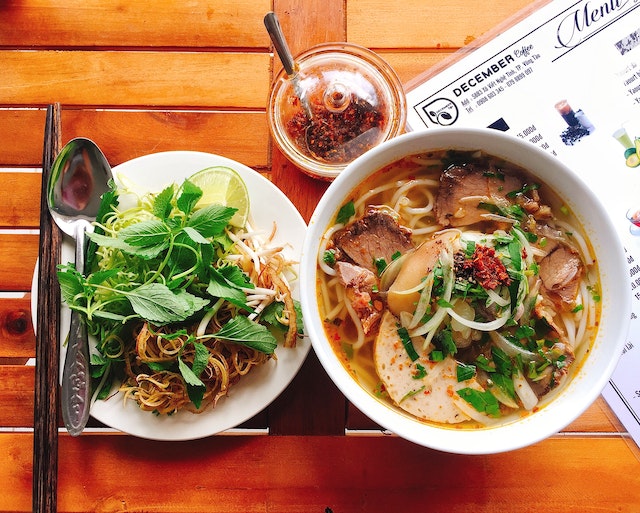The Rise of Asian Fast Food: From Local Delicacy to Global Sensation
If you're a foodie, you're probably well aware of the explosion in popularity of Asian fast food in recent years. From street stalls to high-end restaurants, you can find Asian cuisine all around the world. But how did this happen? How did a local delicacy become a global sensation? Let's dive in and find out.
The Rise of Asian Fast Food: From Local Delicacy to Global Sensation
If you're a foodie, you're probably well aware of the explosion in popularity of Asian fast food in recent years. From street stalls to high-end restaurants, you can find Asian cuisine all around the world. But how did this happen? How did a local delicacy become a global sensation? Let's dive in and find out.

The Origins of Asian Fast Food
To understand the rise of Asian fast food, we need to start at the beginning. Asian cuisine has a long and rich history, with many of its dishes dating back centuries. However, it wasn't until the 20th century that Asian fast food began to take shape.
One of the first Asian fast food chains was Yoshinoya, which opened in Tokyo in 1899. Yoshinoya specialized in beef bowls, which were a hit with Japanese salarymen who were looking for a quick and affordable meal.
In the 1950s and 1960s, other Japanese fast food chains began to emerge, including Mos Burger and Teriyaki Boy. These chains served a range of dishes, from burgers to sushi, and helped to popularize Japanese cuisine around the world.
The Origins of Asian Fast Food
To understand the rise of Asian fast food, we need to start at the beginning. Asian cuisine has a long and rich history, with many of its dishes dating back centuries. However, it wasn't until the 20th century that Asian fast food began to take shape.
One of the first Asian fast food chains was Yoshinoya, which opened in Tokyo in 1899. Yoshinoya specialized in beef bowls, which were a hit with Japanese salarymen who were looking for a quick and affordable meal.
In the 1950s and 1960s, other Japanese fast food chains began to emerge, including Mos Burger and Teriyaki Boy. These chains served a range of dishes, from burgers to sushi, and helped to popularize Japanese cuisine around the world.
At the same time, Chinese cuisine was also gaining popularity. In the United States, Chinese immigrants had been running restaurants since the 1800s. However, it wasn't until the 1950s that Chinese food began to be marketed as "fast food." The first Chinese fast food chain was Panda Express, which opened in California in 1983.
The popularity of Asian fast food continued to grow throughout the 1990s and 2000s. Korean fried chicken, Vietnamese pho, and Thai curry all became popular dishes in their own right. Today, you can find Asian fast food chains all around the world, from Seoul to San Francisco.
The Appeal of Asian Fast Food
So, why has Asian fast food become so popular? There are a few reasons.
Firstly, Asian cuisine is incredibly diverse. From spicy Korean dishes to delicate Japanese sushi, there is something for everyone. This diversity has helped to make Asian fast food appealing to a wide range of people.
Secondly, Asian fast food is often healthier than traditional fast food. Many Asian dishes are made with fresh ingredients, and are lower in fat and calories than burgers and fries. This has helped to make Asian fast food a popular choice for people who are looking for a healthier meal.
Finally, Asian fast food is often affordable. Many Asian dishes are made with inexpensive ingredients, which helps to keep the cost of the meal down. This has helped to make Asian fast food a popular choice for people who are looking for a quick and affordable meal.
At the same time, Chinese cuisine was also gaining popularity. In the United States, Chinese immigrants had been running restaurants since the 1800s. However, it wasn't until the 1950s that Chinese food began to be marketed as "fast food." The first Chinese fast food chain was Panda Express, which opened in California in 1983.
The popularity of Asian fast food continued to grow throughout the 1990s and 2000s. Korean fried chicken, Vietnamese pho, and Thai curry all became popular dishes in their own right. Today, you can find Asian fast food chains all around the world, from Seoul to San Francisco.
The Appeal of Asian Fast Food
So, why has Asian fast food become so popular? There are a few reasons.
Firstly, Asian cuisine is incredibly diverse. From spicy Korean dishes to delicate Japanese sushi, there is something for everyone. This diversity has helped to make Asian fast food appealing to a wide range of people.
Secondly, Asian fast food is often healthier than traditional fast food. Many Asian dishes are made with fresh ingredients, and are lower in fat and calories than burgers and fries. This has helped to make Asian fast food a popular choice for people who are looking for a healthier meal.
Finally, Asian fast food is often affordable. Many Asian dishes are made with inexpensive ingredients, which helps to keep the cost of the meal down. This has helped to make Asian fast food a popular choice for people who are looking for a quick and affordable meal.
The Challenges of Global Expansion
Despite the popularity of Asian fast food, there have been some challenges when it comes to global expansion. One of the biggest challenges has been adapting Asian dishes to suit local tastes.
For example, in the United States, many Asian dishes have been adapted to be sweeter and less spicy than their traditional counterparts. This is because American palates tend to prefer sweeter, milder flavors.
Another challenge has been finding the right balance between authenticity and accessibility. Many Asian fast food chains have had to make changes to their menus in order to appeal to a wider audience. However, this can sometimes lead to accusations of "dumbing down" the cuisine.
The Challenges of Global Expansion
Despite the popularity of Asian fast food, there have been some challenges when it comes to global expansion. One of the biggest challenges has been adapting Asian dishes to suit local tastes.
For example, in the United States, many Asian dishes have been adapted to be sweeter and less spicy than their traditional counterparts. This is because American palates tend to prefer sweeter, milder flavors.
Another challenge has been finding the right balance between authenticity and accessibility. Many Asian fast food chains have had to make changes to their menus in order to appeal to a wider audience. However, this can sometimes lead to accusations of "dumbing down" the cuisine.

The Future of Asian Fast Food
So, what does the future hold for Asian fast food? It seems likely that the popularity of Asian cuisine will continue to grow in the coming years.
One trend that is likely to continue is the fusion of different Asian cuisines. For example, Korean-Mexican fusion cuisine has become popular in recent years, with dishes such as Korean BBQ tacos and ramen burritos. This blending of different cuisines is likely to continue as people become more adventurous with their food choices.
Another trend that is likely to continue is the rise of plant-based and vegetarian Asian fast food options. Many Asian dishes are naturally vegetarian, and there is a growing demand for plant-based alternatives to traditional meat-based dishes.
Finally, technology is likely to play a bigger role in the world of Asian fast food. Many fast food chains are already experimenting with technology such as self-ordering kiosks and mobile ordering apps. This technology not only makes the ordering process more efficient, but it also allows for more customization and personalization of orders.
In conclusion, the rise of Asian fast food is a fascinating story of how a local delicacy became a global sensation. From humble beginnings in Tokyo and California, Asian fast food has become a staple in cities around the world. Its popularity is driven by the diversity, healthiness, and affordability of its dishes. While there have been some challenges along the way, it seems likely that the popularity of Asian fast food will only continue to grow in the years to come. So the next time you're in the mood for a quick and delicious meal, why not try some Asian fast food? You might just discover your new favorite dish.
The Future of Asian Fast Food
So, what does the future hold for Asian fast food? It seems likely that the popularity of Asian cuisine will continue to grow in the coming years.
One trend that is likely to continue is the fusion of different Asian cuisines. For example, Korean-Mexican fusion cuisine has become popular in recent years, with dishes such as Korean BBQ tacos and ramen burritos. This blending of different cuisines is likely to continue as people become more adventurous with their food choices.
Another trend that is likely to continue is the rise of plant-based and vegetarian Asian fast food options. Many Asian dishes are naturally vegetarian, and there is a growing demand for plant-based alternatives to traditional meat-based dishes.
Finally, technology is likely to play a bigger role in the world of Asian fast food. Many fast food chains are already experimenting with technology such as self-ordering kiosks and mobile ordering apps. This technology not only makes the ordering process more efficient, but it also allows for more customization and personalization of orders.
In conclusion, the rise of Asian fast food is a fascinating story of how a local delicacy became a global sensation. From humble beginnings in Tokyo and California, Asian fast food has become a staple in cities around the world. Its popularity is driven by the diversity, healthiness, and affordability of its dishes. While there have been some challenges along the way, it seems likely that the popularity of Asian fast food will only continue to grow in the years to come. So the next time you're in the mood for a quick and delicious meal, why not try some Asian fast food? You might just discover your new favorite dish.





























